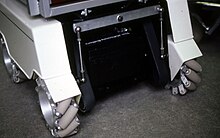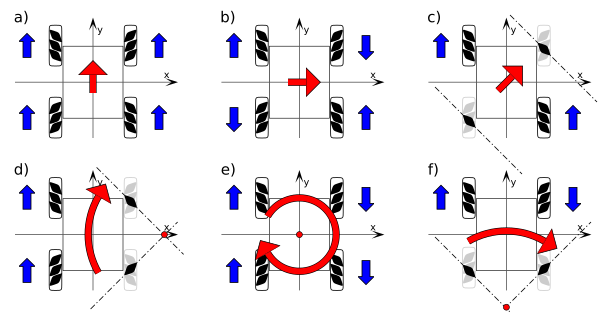Mecanum wheel


The Mecanum wheel is a wheel that allows a vehicle equipped with it to perform omnidirectional driving maneuvers without having to be equipped with mechanical steering . It is sometimes called the Ilon wheel after its inventor, Bengt Ilon . The US patent for this wheel was filed on November 13, 1972 with Bengt Ilon as inventor and patent holder. The related German patent was filed on October 30, 1973. In contrast to the all-side wheel , the Mecanum wheel has rollers at an angle to the main axis.
technology
On the circumference (the "rim") of the wheel there are several rotatable barrel-shaped rollers, usually at an angle of 45 degrees to the axis of the entire wheel. Only these roles establish contact with the ground. These rollers have no direct drive and can rotate freely around their inclined bearing axis. The entire Mecanum wheel, on the other hand, is driven by a drive motor with a variable direction of rotation and variable speed.
The vehicles equipped with it usually have four such wheels, which are arranged in a rectangle ("carriage arrangement"). The axes of the inclined rollers must either point in a star shape to the center of the vehicle or all the angular axes of the rollers must be on a circular projection (different choice of angles of the rollers on the front and rear axles - each + 45 ° or −45 ° to the axis of the Mecanum Wheel). If this criterion is not observed, no omnidirectional driving forces can be generated. Rotation around their center point is only possible with the arrangement of the bearing surfaces in circular projection, which is desirable in most applications.
The speed and direction of rotation of each wheel can be controlled individually. By individually selecting the direction of rotation of the wheels, force vectors are created in relation to the road surface, which are formed in two directions by the movable rollers, but add up to a total direction of movement or a torque for the entire vehicle together with the vectors of the other wheels. It is crucial that, depending on the direction of the forces, the rollers on the ground partially rotate or are simply unrolled by the wheel on which they are located without turning themselves - for example when driving straight ahead. In extreme cases, such a vehicle can only move transversely by rotating the wheels of the front and rear axles in opposite directions without having to move "forwards" or rotate around the vertical axis.
Applications are, for example, conveyor vehicles, mobility aids for people with walking difficulties , driverless transport vehicles , in intralogistics, on patient beds and operating tables, in production processes, for example in machine, aircraft or vehicle construction, and also in robotics .
history
The United States Navy bought the patent from Ilon and developed it further in Panama City in 1980 . The Navy used it to carry loads on ships.
In 1997, Airtrax Inc. and several other companies each paid the Navy $ 2,500 for the technology. Airtrax developed, among other things, a forklift truck that can be moved easily in tight spaces and was marketed until 2008.
Individual evidence
- ↑ https://www.google.com/patents/US3876255
- ↑ https://register.dpma.de/DPMAregister/pat/register?AKZ=23544049&CURSOR=0
- ↑ Brent Bowers: 8 Patterns of Highly Effective Entrepreneurs . Crown Publishing Group, November 26, 2008, ISBN 978-0-307-48108-5 , pp. 7-8.
- ↑ http://www.airtrax.com/
Web links
- YouTube video of an AGV with Mecanum wheels
- Patent US3876255 : Wheels for a course stable self-propelling vehicle movable in any desired direction on the ground or some other base. Applied on November 13, 1972 , published on April 8, 1975 , applicant: Bengt Ilon Erland, inventor: Bengt Ilon Erland.
- Drive concept for Mecanum wheels at www.miag.de
- YouTube video of a model robot with Mecanum wheels
- YouTube video of an AGV with an omnidirectional Mecanum chassis
- Manufacture and development of Mecanum wheels and chassis

